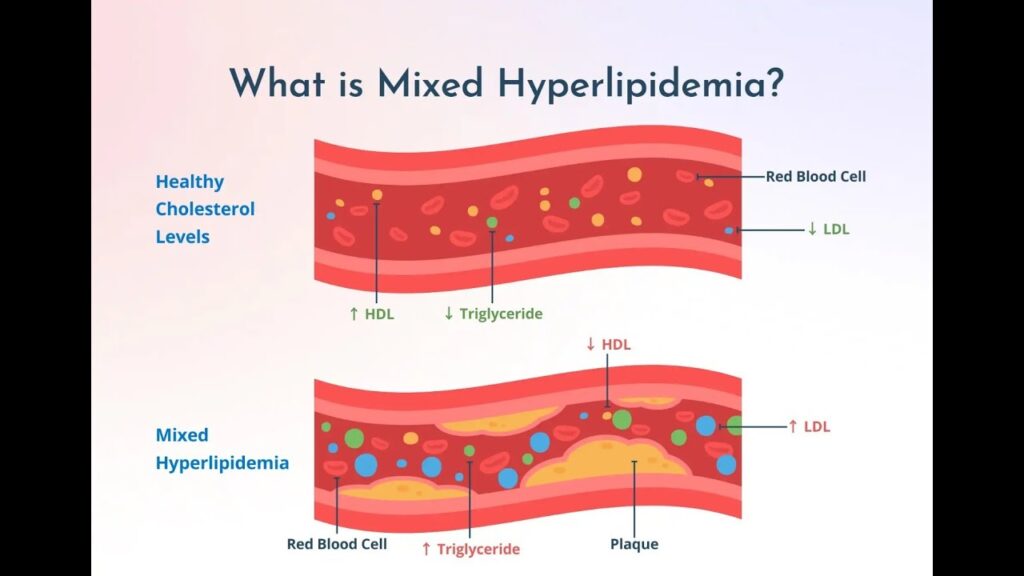Mixed hyperlipidemia is a metabolic disorder characterized by elevated levels of low-density lipoprotein (LDL) cholesterol, high triglycerides, and low levels of high-density lipoprotein (HDL) cholesterol. It increases the risk of cardiovascular diseases, including atherosclerosis, heart attacks, and strokes.

Causes and Risk Factors
Genetic Factors
Familial combined hyperlipidemia (FCHL) is the most common hereditary cause. It leads to increased lipid production and altered metabolism.
Lifestyle and Dietary Habits
- High intake of saturated fats and trans fats
- Excessive consumption of refined carbohydrates and sugars
- Sedentary lifestyle and lack of physical activity
Underlying Medical Conditions
- Diabetes mellitus: Alters lipid metabolism, increasing triglycerides
- Hypothyroidism: Reduces lipid clearance, leading to high cholesterol
- Kidney disease: Impairs lipid metabolism, elevating lipid levels
- Obesity: Contributes to insulin resistance and dyslipidemia
Symptoms of Mixed Hyperlipidemia
Mixed hyperlipidemia is often asymptomatic but can manifest as:
- Xanthomas (fat deposits in skin and tendons)
- Xanthelasma (cholesterol deposits around eyes)
- Corneal arcus (white ring around the cornea)
- Chest pain or angina due to atherosclerosis
- Fatigue and shortness of breath in severe cases
Diagnosis and Laboratory Tests
Lipid Profile Tests
- Total cholesterol: Elevated levels above 200 mg/dL
- LDL cholesterol: High levels (>130 mg/dL)
- HDL cholesterol: Low levels (<40 mg/dL in men, <50 mg/dL in women)
- Triglycerides: Increased levels (>150 mg/dL)
Additional Diagnostic Measures
- Genetic testing for familial hyperlipidemia
- Liver function tests to assess lipid metabolism
- Fasting glucose test to check for insulin resistance
- Coronary artery calcium (CAC) scan to detect atherosclerosis
Health Risks and Complications
- Atherosclerosis: Narrowing of arteries due to plaque buildup
- Coronary artery disease (CAD): Leads to heart attacks and angina
- Stroke: Increased risk due to artery blockages
- Pancreatitis: High triglyceride levels can cause acute inflammation
- Metabolic syndrome: Associated with obesity and insulin resistance
Treatment and Management Strategies
Lifestyle Modifications
- Dietary changes: Adopting a heart-healthy diet (Mediterranean diet, DASH diet)
- Regular exercise: At least 150 minutes of moderate-intensity exercise weekly
- Weight management: Reducing body weight to improve lipid levels
Medications for Lipid Control
- Statins: Lower LDL cholesterol (e.g., atorvastatin, rosuvastatin)
- Fibrates: Reduce triglycerides (e.g., fenofibrate, gemfibrozil)
- Niacin (Vitamin B3): Increases HDL and lowers triglycerides
- PCSK9 inhibitors: Lower LDL in high-risk patients
Emerging Therapies
- Gene therapy: Targeting lipid metabolism genes
- RNA-based drugs: Inhibiting specific lipid-producing enzymes
- Omega-3 fatty acids: Reducing triglyceride levels naturally
Preventive Measures
- Regular health checkups: Monitoring lipid profiles and cardiovascular risk factors
- Early intervention: Lifestyle modifications before complications arise
- Smoking cessation: Reducing cardiovascular risk
- Stress management: Lowering cortisol levels to improve lipid metabolism
Mixed hyperlipidemia is a serious metabolic disorder requiring early diagnosis and proactive management. Through lifestyle changes, medications, and emerging therapies, individuals can significantly reduce their cardiovascular risk and improve overall health.

